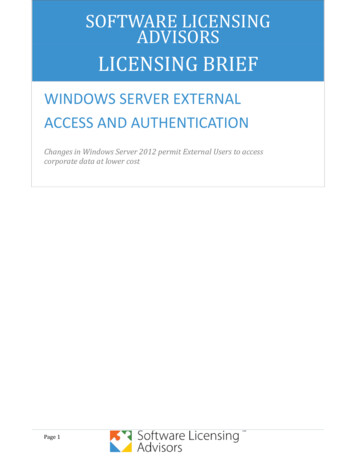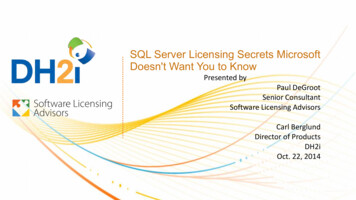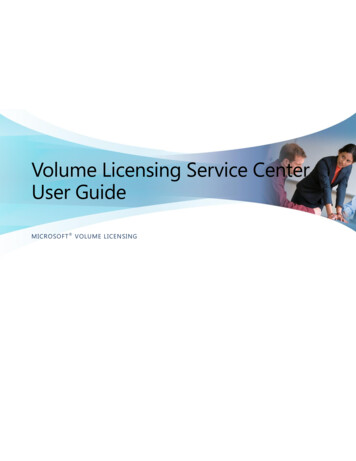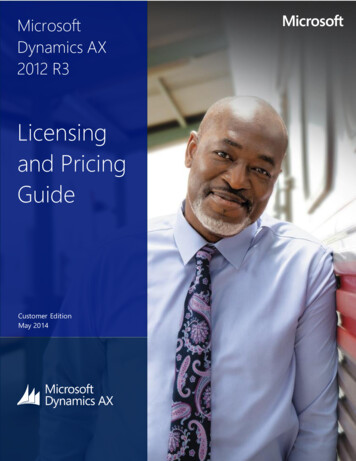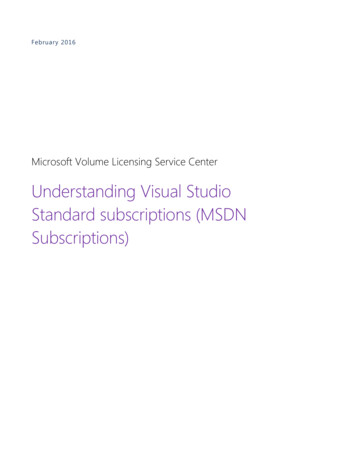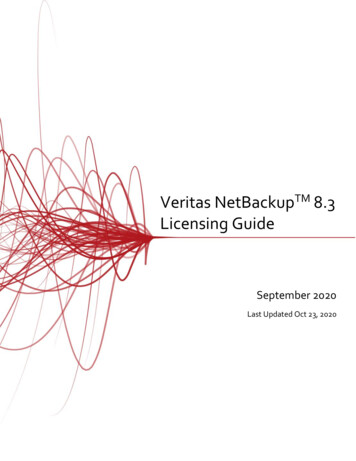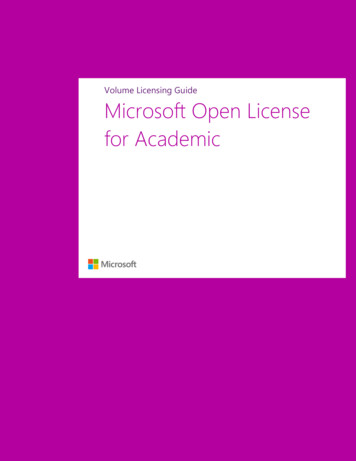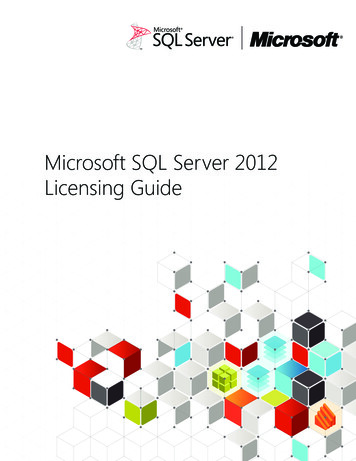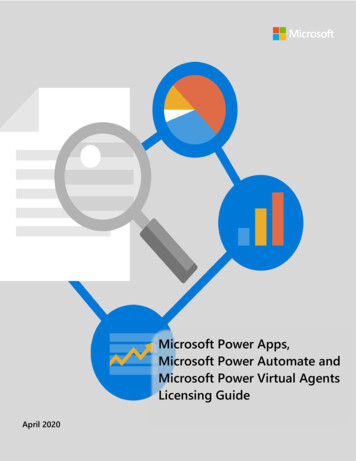
Transcription
Microsoft Power Apps,Microsoft Power Automate andMicrosoft Power Virtual AgentsLicensing GuideApril 2020Power Apps and Microsoft Flow Licensing Guide October 2019
Table of ContentsHow to buy . 2Licensing Programs. 2How to license . 2Multiplexing . 2Licensing Requirements for External Users . 3Power Apps Subscriptions . 3Power Apps . 3Power Apps Portals . 7Power Automate Subscriptions . 9Power Automate . 9Power Automate per user with attended RPA plan . 11Power Automate unattended RPA add-on . 11Power Virtual Agents subscriptions . 14Subscription Capacity . 15Capacity Add-ons . 16Common Data Service Capacity Add-ons . 17AI Builder capacity add-on . 17Power Apps and Power Automate capacity add-on. 18Power Virtual Agents capacity add-on . 18Trial and Implementation . 19Power Platform Service Support. 19Pricing . 19Additional Resources . 19Appendix A: Terminology and Custom Entities . 20Appendix B: Standard Connectors moved to premium category . 22Appendix C: Dynamics 365 and Office 365 licenses that include Power Apps and Power Automatecapabilities . 23Appendix D: Change Log . 24Power Apps, Power Automate and Power Virtual Agents Licensing Guide April 2020
Using This GuideUse this guide to improve your understanding of how to license Microsoft Power Apps, Power Automate(previously known as Microsoft Flow) and Power Virtual Agents.This guide is not intended to influence the choice of Microsoft products and services. The examplespresented in this guide are illustrative. Microsoft reserves the right to review or update this document atany time without notice.This document applies for users with Power Apps, Power Automate and Power Virtual Agents licenses.To facilitate understanding of licensing requirements this guide is structured as follows:1) What’s new2) Channel Licensing (how to buy)3) How to license (product licensing)4) Add-ons5) Notes: ChangesFor help determining the right technology solution for any given organization, including the licenserequirements for a specific product or scenario, consult with your Microsoft account team or yourMicrosoft Certified Partner. This guide does not supersede or replace any of the legal documentationcovering use rights.What’s new in this licensing guideSee the Change log Appendix D, for minor changes effective April 2020.Power Apps, Power Automate and Power Virtual Agents Licensing Guide April 2020P a g e 1
How to buyLicensing ProgramsLicensing programs are channels where you can buy Power Apps, Power Automate and Power VirtualAgents. You can license Power Apps, Power Automate and Microsoft Power Virtual Agents throughMicrosoft Volume Licensing (VL), Cloud Solution Provider program (CSP), and/or Web Direct (MOSP)programs. In Volume Licensing, Power Apps and Power Automate are available through: Enterprise Agreement (EA)Enterprise Agreement Subscription (EAS)Service and Cloud Enrollment (SCE)Enrollment for Education Solutions (under the Campus and School Agreement) (EES)Additional channels: Microsoft Online Government Microsoft Products and Services Agreement (MPSA). More information on MPSA is available here. Microsoft Online Subscription Program (Web Direct/MOSP)For more information on Power Apps, Power Automate, and Power Virtual Agents licensing channels andsegment availability, refer to the Product Terms and the Online Service Terms.Participating in a Volume Licensing program typically involves signing an agreement and/or enrollment,meeting a minimum purchase requirement, and ordering licenses through a Microsoft Reseller. Visit theMicrosoft Volume Licensing website to learn more about how to buy through Volume Licensing, find areseller partner, and more helpful information.How to licenseMultiplexingMultiplexing refers to the use of hardware or software that a customer uses to pool connections, rerouteinformation, or reduce the number of users that directly access or use the Power Apps, Power Automateand Power Virtual Agents service. Multiplexing does NOT reduce the number of SLs of any type requiredto access the Power Apps, Power Automate and Power Virtual Agents apps. Any user or device thataccesses the Power Apps, Power Automate and Power Virtual Agents app —whether directly orindirectly—must be properly licensed.Power Apps, Power Automate and Power Virtual Agents service can only be accessed if you have a PowerApps, Power Automate or Power Virtual Agents license. Similarly, Power Apps, Power Automate andPower Virtual Agents licenses are required for users that input data into, query, or view data from thePower Apps, Power Automate and Power Virtual Agents apps through a pooling device. Pooledconnections use a non-interactive user account in Power Apps, Power Automate and Power Virtual Agentsthat can access the system but only via the web service layer. Internal users accessing Power Apps, PowerAutomate and Power Virtual Agents service indirectly through a portal or via an API to a separate servicesuch Microsoft Outlook must also be properly licensed, regardless of if they are set up as a Power Apps,Power Automate and Power Virtual Agents user in the app, for example: Internal users that access the Power Apps, Power Automate and Power Virtual Agents servicemust still be properly licensed for Power Apps, Power Automate and Power Virtual Agents. Any user that accesses Power Apps, Power Automate and Power Virtual Agents service that ismade available through an automated process requires a Power Apps, Power Automate andPower Virtual Agents licensePower Apps, Power Automate and Power Virtual Agents Licensing Guide April 2020P a g e 2
The number of tiers of hardware or software between the Power Apps, Power Automate andPower Virtual Agents apps and the user or devices that ultimately use Power Apps, PowerAutomate and Power Virtual Agents service indirectly does not affect the number of SLs required.For additional information about multiplexing refer to the Microsoft Volume Licensing BriefMultiplexing—Client Access License (CAL) Requirements.Licensing Requirements for External UsersExternal users must be appropriately licensed to access Power Platform services and data. Applicablelicensing includes: An appropriate Power Platform USL Seeded licensing capabilities from Office or Dynamics 365 USLs Power Portal login or page view capacity Accessing via an appropriately licensed Power Automate Per Flow workflowUsers must be appropriately licensed whether they are accessing directly or indirectly per multiplexingguidelines.For additional information about multiplexing refer to the Microsoft Volume Licensing BriefMultiplexing—Client Access License (CAL) Requirements. Note, this document is intended to providegeneral multiplexing guidance that can be used for online as well as on-premises situations.For additional information on external guest user access please see here.Power Apps SubscriptionsPower AppsService OverviewPower Apps is a low code/no code application platform that allowsenterprises to digitize business operations by easily building line ofbusiness applications and customizing existing Office 365 andDynamics 365 applications. For more details, please visithttps://powerapps.microsoft.comLicensing overviewGeneral purpose, full Power Apps capabilities are licensed on a standalone basis. Additionally, limitedPower Apps capabilities are included within various Office 365 and Dynamics 365 licenses; for moreinformation, please see the sections titled Power Apps use rights included with Dynamics 365/Office 365licenses later in this document.High level overview of the licensing structure is provided below.Licensing schemeDescription1Per user, per appPer userPer user, per appPer userAllow individual users to run applications1for a specific business scenario based on thefull capabilities of Power AppsEquip users to run unlimited applicationsbased on the full capabilities of Power AppsEach license allows end user to run 2 custom apps and access 1 custom portalPower Apps, Power Automate and Power Virtual Agents Licensing Guide April 2020P a g e 3
Standalone Power Apps licensingCustomers that need general purpose and full capabilities of the platform should license Power Apps on astandalone basis. Licensing is supported on both a “per user” basis as well as a “per user, per app” basis.Both standalone licenses are fully featured. Details follow.Power Apps per app planPower Apps per app plan allows organizations to get started with the platform at a lower entry point.Customers on the per app plan typically start with 1-2 leading use case scenarios before adopting theplatform more broadly. Power Apps per app plan is also an attractive licensing option to license end usersthat run only a few apps.Power Apps per app plan allows individual users to run 2 custom applications (be it canvas or model orboth) and access 1 custom portal based on the full capabilities of Power Apps.Per user, per app offer summarySKU NamePower Apps per app planLicense typePer user licenseLicense assignmentIn productAre licenses stackable?YesEntitlement Summary for Power Apps per app licensePlans and capabilitiesRun custom apps /portalsConnect to your dataRun custom apps (both canvas and model driven)Access custom portalsPower Appsper app plan2 apps1 custom portalStandard connectors Premium connectors On premises data gateway Custom connectors Utilize Common Data Service Store and manage data Create and access custom entities (includes complex entities)Dynamics 365 restricted entitiesExecute workflowsPower Automate use rights Read onlyWithin app contextClassic Common Data Service non real-time and real-time workflowsCommon Data Service DatabasePer license capacityaccess1 Capacity250 MBCommon Data Service File Capacity2400 MBDaily API request limit3Infuse AI1,000AI Builder capacity add-on An entity within Common Data Service becomes restricted only if the Dynamics 365 application is installed on a given environment2Common Data Service database and file capacity entitlements are pooled at the tenant level3Service limits are published at http://aka.ms/platformlimits – Power Apps and Power Automate capacity add-on can be purchasedto increase daily service limits1Note: Embedded canvas apps within a model-driven app will not count towards the two-app limit.A single user might be covered by multiple ‘per app’ licenses to allow the user to use multiplesolutions targeted at various business scenarios, without requiring a per-user licenseOnce a pool of Power Apps per app licenses are purchased, individual licenses need to beassigned to specific environments and to individual users (i.e. if the same app exists in twoenvironments, a user would require two per app SLs to access both).The Power Apps Per App plan is available to education customers under faculty and studentpricing. Since these licenses are sold as tenant level capacity and not assigned to users in activePower Apps, Power Automate and Power Virtual Agents Licensing Guide April 2020P a g e 4
directory, customers and partners will be responsible for ensuring that student pricing is onlybeing applied to students. This means that when licenses are purchased with student pricing, thenumber of app licenses assigned to non-students (i.e. faculty) in the product may not exceed thenumber of faculty licenses purchased as this would indicate that student licenses have beenassigned to faculty.Power Apps per user planPower Apps per user plan allows licensed users to run unlimited custom applications based on the fullcapabilities of Power Apps.Per user offer summarySKU NameLicense typePower Apps per user planUser licenseEntitlement Summary for Power Apps per user licensePlans and capabilitiesRun custom apps (both canvas and model driven)Access custom portalsStandard connectorsPremium connectorsConnect to your dataOn premise data gatewayCustom connectorsUtilize Common Data ServiceStore and manageCreate and access custom entities (includes complex entities)dataDynamics 365 restricted entities access1Power Automate use rightsExecute workflowsClassic Common Data Service non real-time and real-timeworkflowsCommon Data Service Database Capacity2Per license capacity Common Data Service File Capacity2Daily API request limit3Infuse AIAI Builder capacity add-onRun custom apps /portalsPower Appsper user planUnlimitedUnlimited Read onlyWithin app context 250 MB2 GB5,000 An entity within Common Data Service becomes restricted only if the Dynamics 365 application is installed on a given environmentCommon Data Service database and file capacity entitlements are pooled at the tenant level3Service limits are published at http://aka.ms/platformlimits – Power Apps and Power Automate capacity add-on can be purchasedto increase daily service limits12Power Apps use rights included with Dynamics 365 licensesLimited Power Apps use rights are included within the same environment(s) as the licensed Dynamics 365application(s) to allow users to customize & extend Dynamics 365 applications. Use of Power Appscapabilities included with Dynamics 365 licenses must be only within the context of the licensed Dynamics365 application. Further, the specific use rights vary by Dynamics 365 license type.Power Apps, Power Automate and Power Virtual Agents Licensing Guide April 2020P a g e 5
Power Apps use rights with Dynamics 365 applicationsDynamics 365Applications1CapabilitiesRun custom apps3Connect to your dataStore and managedataExecute workflowsInfuse AIPower Apps Portaluse rightsRun standalone apps (canvas/model driven)-Use pre-built connectors (standard, premium) connectorsUsecustom and on-premises connectors Utilize Common Data Service Create and access custom entities15 per applicationCreate, read,Dynamics 365 restricted entities use rightsupdate and deleteWithin appPower Automate use rightscontextClassic Common Data Service non real-time and real-time workflowsAI Builder capacity add-on Standalone Power Apps Portals use rights-Dynamics 365 EnterpriseApplications2Within same environment(s)as licensed Dynamics 365application(s)4 Create, read, update anddeleteWithin app context Within same environment(s)as licensed Dynamics 365application(s)Dynamics 365 Sales Professional, Dynamics 365 Customer Service Professional, Dynamics 365 Team Members, Dynamics 365Operations – Activity, Dynamics 365 Human Resources Self Service, Dynamics 365 Business Central Team Members2Dynamics 365 Sales Enterprise, Dynamics 365 Customer Service Enterprise, Dynamics 365 Field Service, Dynamics 365 ProjectService Automation, Dynamics 365 Finance, Dynamics 365 Supply Chain Management, Dynamics 365 Commerce, Dynamics 365Human Resources, Dynamics 365 Business Central3Power Apps and Power Automate usage will count against the API request limits provided by the Dynamics 365 license Servicelimits are published at http://aka.ms/platformlimits – Power Apps and Power Automate capacity add-on can be purchased toincrease daily service limits4For Finance, Supply Chain Management, and Commerce, the Dynamics 365 environment is defined as the environment that thedual write feature is configured against. For Business Central the Dynamics 365 environment is defined as an environment thatincludes one or more Power Apps that integrate with Business Central1Power Apps use rights included with Office 365 licensesLimited Power Apps use rights are included with select Office 365 licenses to allow users to customize &extend Office 365 for productivity scenarios. For a complete list of Office 365 licenses that include PowerApps use rights, please refer to Appendix C.Power Apps use rights with Office 365 licensesCapabilitiesOffice 365UnlimitedRun custom apps (canvas apps)Run custom apps/portalsRun custom apps (model driven apps)-Access custom portals-Standard connectors (see Appendix B) Premium connectors-On premise data gateway-Custom connectors-Utilize Common Data Service-Create and access custom entities (includes complex entities)-Execute workflowsPower Automate use rights (See Power Automate with Office 365 section) Per license capacityCapacity1Connect to your dataStore and manage data(shared capacity across all PowerApps and Power Automate usage)1Common Data Service DatabaseCommon Data Service File Capacity-1Daily API request limit22,000Common Data Service database and file capacity entitlements are pooled at the tenant levelReference http://aka.ms/platformlimits for more details on usage limits; “Power Apps and Power Automate capacity add-on” can bepurchased to increase daily service limits.2Power Apps, Power Automate and Power Virtual Agents Licensing Guide April 2020P a g e 6
Power Apps PortalsService OverviewPower Apps Portals deliver the capability to build standalone,external-facing portals over the Common Data Service. For moreinformation on Power Apps Portals, please ps-portals/Licensing overviewProvisioning a Power Apps Portals instancePower Apps Portals instances can be provisioned by customers on-demand. Provisioning a portalsinstance draws 1GB from available (unused) Common Data Service database capacity. Thus, provisioningadditional portals instances is only capped by available Common Data Service database capacity.Usage of a Power Apps Portals instanceEach end user that accesses a Power Apps Portals instance needs to be licensed appropriately. The tablebelow outlines the end user types.End user typeDescriptionObtains secure access to personalized data byutilizing authentication mechanisms such asAzure AD B2C, LinkedIn, Okta, etc.Access publicly viewable web pages powered bythe portalA user licensed with Power Apps or Dynamics365External user(authenticated)Anonymous userInternal userUse case examples B2B - Partner management (Dealer,Supplier, Franchise etc.) B2C – Account management etc.Knowledge management sitesEmployee self-serveThe licensing scheme varies based on end user type.End user typeExternal user(authenticated)Anonymous userInternal userLicensing modelPer loginDescriptionA login provides the authenticated user with access to a singleportal for up to 24 hours. Multiple logins during the 24-hourperiod count as 1 billable loginThink of a login as a day pass to a single Power Apps PortalPer page view License fee pays for access toPower Apps PortalsCustom portal use rights are aligned with custom app use rights No additional monetizationPer login modelFor Power Apps Portals instances that implement authenticated external user scenarios, appropriate logincapacity, based on anticipated usage volumes, should be purchased. Customers should purchasenecessary capacity of logins across all Portals instances that cater to authenticated external user scenarios.SKU NamesPowerApps Portals login capacity add-onPowerApps Portals login capacity add-on tier-2PowerApps Portals login capacity add-on tier-3Unit nnel1100 loginsAll101,000 loginsAll505,000 loginsCSP onlyEach unit provides 100 logins/month. Volume tiers and corresponding SKUs differ based on minimumpurchase requirements. For each of the tiers, once the minimum purchase requirement is met, additionalunits can be purchased in units of 1.For example, a customer requiring 5,500 logins/month can purchase 55 units of “Power Apps Portals logincapacity add-on tier-3”Power Apps, Power Automate and Power Virtual Agents Licensing Guide April 2020P a g e 7
Capacity enforcementFor Power Apps Portals login capacity add-on SKUs, purchased capacity is enforced monthly. Unusedlogins do NOT carry over from one month to another. Customers should purchase appropriate capacityaligned with peak monthly anticipated usage.Overage handlingWhile occasional and reasonable overages will be tolerated, customers exceeding purchased capacityshould adjust their purchase quantity per standard Microsoft terms to remain in compliance.Assignment of purchased capacityThe minimum assignment capacity per Power Apps Portal instance is 100 logins/month. Once theminimum capacity of 100 logins/month is assigned, additional logins can be added in terms of 1 login.Per page view modelFor Power Apps Portals instances that implement anonymous access scenarios, appropriate capacity ofpage views, based on anticipated usage, should be purchased. Customers should purchase necessarypage views capacity across all Portals instances that cater to anonymous access scenarios.SKU NamePower Apps Portals page view capacity add-onUnit Capacity100,000page views/monthChannelsAllEach unit provides 100,000-page views per month. For example, a customer requiring 570,000-page viewsper month, should purchase 6 units of “Power Apps Portals page view capacity add-on”Capacity enforcementFor Power Apps Portals pageview capacity add-on SKUs, purchased capacity is enforced monthly. Unusedpage views do NOT carry over from one month to another. Customers should purchase appropriatecapacity aligned with peak monthly anticipated usage.Overage handlingWhile occasional and reasonable overages will be tolerated, customers exceeding purchased capacityshould adjust their purchase quantity per standard Microsoft terms to remain in compliance.Assignment of purchased capacityThe minimum assignment capacity per Power Apps Portal instance is 50,000-page views/month. Once theminimum capacity is assigned, additional page views can be added in terms of 1-page viewPower Apps Portals – Use rights for Internal usersFor internal users i.e. users licensed with Power Apps or Dynamics 365 licenses, the use rights for PowerApps Portals which are essentially custom portals aligns with use rights to custom Power Apps.LicenseDynamics 365 Team MembersDynamics 365 Operations - ActivityDynamics 365 Professional license1Dynamics 365 Enterprise license2Power Apps per appPower Apps per userOffice 36512Custom Power Apps Portals use rightsNoneNoneNone Power Apps Portals that map to licensed Dynamics 365 application context Power Apps Portals that map to the same environment as the licensedDynamics 365 application1 Power Apps portalUnlimited Power Apps portalsNoneDynamics 365 Sales Professional, Dynamics 365 Customer Service ProfessionalDynamics 365 Sales Enterprise, Dynamics 365 Customer Service Enterprise, Dynamics 365 Field Service, Dynamics 365 ProjectService Automation, Dynamics 365 Finance, Dynamics 365 Supply Chain Management, Dynamics 365 Commerce, Dynamics 365Human Resources, Dynamics 365 Business CentralPower Apps, Power Automate and Power Virtual Agents Licensing Guide April 2020P a g e 8
API limits for Power Apps portalsEach login provides a daily limit entitlement of 200 API calls per 24-hour period per user. Anonymouspage views, which rarely interact with backend system functionality, are afforded up to 3 API calls perpage view.These API calls are pooled at portal level depending on number of logins/page views assigned to portal.Power Automate SubscriptionsPower AutomateService OverviewPower Automate allows enterprises to implement automated workflows andbusiness processes and achieve operational efficiencies. For more details, pleasevisit https://flow.microsoft.com.Licensing overviewGeneral purpose Power Automate capabilities are licensed on a standalone basis. Limited PowerAutomate capabilities are also included within Power Apps, Office 365 and Dynamics 365 licenses; formore information, please see the sections titled Power Automate use rights included with Dynamics365/Office 365 licenses later in this document.High level overview of the licensing structure is provided below.Power AutomatePer userPer user with attended RPALicensing schemePer userPer userAllow individual users tocreate unlimited flowsbased on their unique needs.Allow individual users to createunlimited flows, plus automatelegacy applications throughRobotic Process Automation(RPA) and AI.DescriptionPer flowPer flow(Minimum purchase of 5 flows)Implement flows withreserved capacity that serveunlimited users across anorganization.Standalone Power Automate licensingCustomers that need full-fledged, general purpose workflow, business process automation or RoboticProcess Automation (RPA) capabilities, should consider purchasing standalone Power Automate licenses.Licensing is supported on both a “per user” basis as well as a “per flow” basis. All standalone licenses includethe full capabilities on Power Automate with the exception of RPA functionality which is only included in PowerAutomate per use with attended RPA plan.Power Automate per user planPower Automate per user plan equips individual users to create and run unlimited workflows andbusiness processes based on their unique needs. The per user plan is intended to support the broadadoption of an automation culture in an organization. Should the entire organization be licensed with thePower Automate per user plan, admins will have minimal overhead with tracking how many flows arebeing activated/used within the organization.Per user offer detailsSKU NameEnabled flowsUsage limitPower Automate per user planUnlimited5,000 daily API requests“Power Apps and Power Automate capacity add-on” can be purchased to increase daily service limits.Power Apps, Power Automate and Power Virtual Agents Licensing Guide April 2020P a g e 9
Power Automate per flow planThe Power Automate per flow plan is licensed by flow and allows customers to implement critical businessprocesses with capacity that serves teams, departments, or the entire organization without individuallylicensing each end user that triggers the licensed flow.Power Automate per flow plan is great for departmental scenarios where typically, one power user sets upa flow and shares the same with th
Customers on the per app plan typically start with 1-2 leading use case scenarios before adopting the platform more broadly. Power Apps per app plan is also an attractive licensing option to license end users that run only a few apps. Power Apps per app plan allows individual use
